【公开课教案】高中英语选修六unit1-art Reading教学设计
- 格式:doc
- 大小:91.50 KB
- 文档页数:4

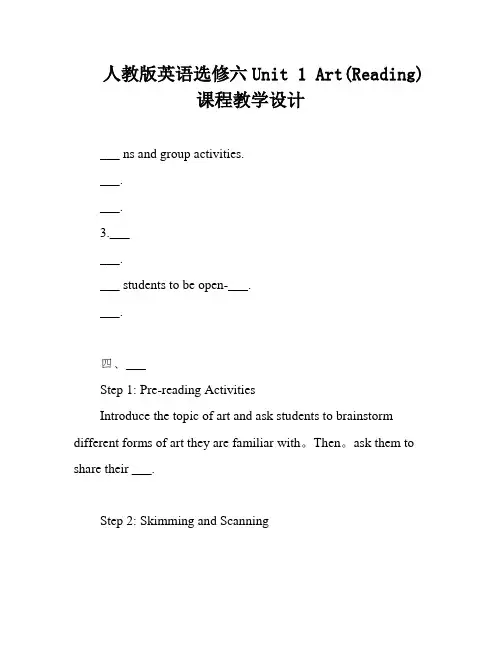
人教版英语选修六Unit 1 Art(Reading)课程教学设计___ ns and group activities.___.___.3.______.___ students to be open-___.___.四、___Step 1: Pre-reading ActivitiesIntroduce the topic of art and ask students to brainstorm different forms of art they are familiar with。
Then。
ask them to share their ___.Step 2: Skimming and ScanningAsk students to read the passage quickly and identify the main ideas of each paragraph。
Then。
have them scan the text for specific n related to the new words and ___.Step 3: Group nDivide the class into groups and assign each group a specific art movement or style to analyze。
Have them discuss the characteristics of the style。
its major artists and works。
and the ___ it emerged.Step 4: ___ AssignmentsAsk students to write a short ___ from the text and their own research to support their arguments.Step 5: nsHave students present their findings from the group n and ___ them to use visual aids such as images and ___.Step 6: nAsk ___ them to think about how they can apply this knowledge to their own lives and future careers.五、Assessment and ___Assess students’ ___ to help students improve their reading and critical ___.1.Understanding the cultural background and significance of ___.2.___ paintings.During the warm-up。
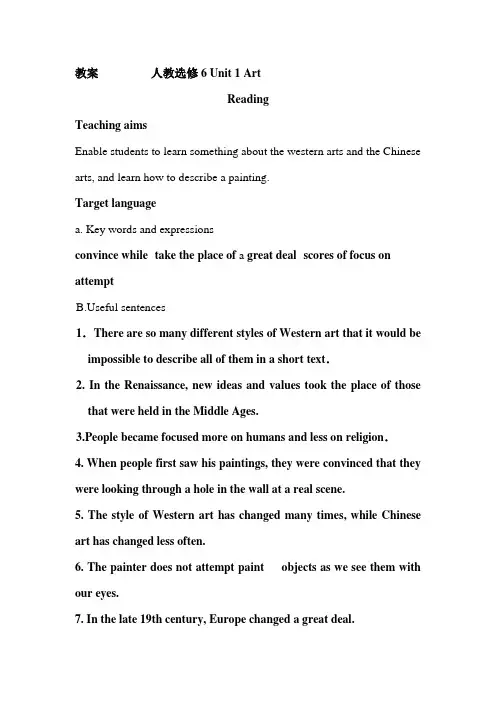
教案人教选修6 Unit 1 ArtReadingTeaching aimsEnable students to learn something about the western arts and the Chinese arts, and learn how to describe a painting.Target languagea. Key words and expressionsconvince while take the place of a great deal scores of focus on attempteful sentences1.There are so many different styles of Western art that it would be impossible to describe all of them in a short text.2. In the Renaissance, new ideas and values took the place of thosethat were held in the Middle Ages.3.People became focused more on humans and less on religion.4. When people first saw his paintings, they were convinced that they were looking through a hole in the wall at a real scene.5. The style of Western art has changed many times, while Chinese art has changed less often.6. The painter does not attempt paint objects as we see them with our eyes.7. In the late 19th century, Europe changed a great deal.8. Nowadays, there are scores of modern art styles.Learning ability goalsEnable the students to learn the different styles of the western arts. Teaching important pointsHow to make students tell the characteristics, styles of the western arts.Teaching aidsA projector, a tape-recorder and a blackboardTeaching proceduresStep1 BrainstormingT: How much do you know about art? Have you ever been to an art gallery? Do you find your visit interesting? What can you think of when looking at the word “art”?Slide showPaintings art museumsart painters artistsart works art galleries The Renaissance Mona LisaStep2 Pre-readingT: Today we will learn more about the western art, now please look at the screen.Slide show1. Have you visited art galleries?2. What are the names of some famous Western or Chinese artists?3. The following paintings are all very famous. Can you guess their names and their painters? What styles they belong to?Step3 Fast readingSlide show1. Read the text quickly and answer the following questions.1.What’s the main idea of the text?2.How many styles are mentioned in the passage and what are theirnames?Keys:1. The style of Western art has changed a lot with time going by.2. Four. They are: The Middle Ages, The Renaissance, Impressionism and Modern art.2. Listen to the text carefully, fill in the blanks, and pay attention to the time expressions.1. The style of Western art has changed____________, while Chineseart has changed________.2. China, unlike Europe, hasfollowed___________________________.3. This text will describe only a few of the main styles starting___________________.4. During the Middle Ages, the main aim of painters was to_________5. Things had begun to change ________6._______________________,____________________took the place of those that were held in the Middle Ages.7. One of the most important discoveries ___________________was how to draw things in perspective.8. The first person to use perspective in his paintings was_________.9. ____________________________they were convinced they were looking...10.____________________, oil paints were also developed,..11._____________________,Europe changed a great deal…12. ________, most people hated this new style of painting.13._________________________, the impressionists’ paintings were controversial…14.__________, there are scores of modern art styles…15. It is interesting to predict what styles of painting there willbe_____Keys:1. many times less often2. similar way of life for a very long time.3. from the 5th century AD4.represent religious themes5. by the13th century6.In the Renaissance new ideas and values7.during this period8.Masaccio in 14289. When people first saw his paintings 10.During the Renaissance 11.In the late 19th century 12.At first13.At the time they were created 14.Nowadays 15.in the future Step 4 Detailed reading1. Read the passage in details, discuss in groups and fill in the table2. Read the passage again and do Exercise 2 on Page3. T&F Questions.1. Western art has changed very little over the last 17 centuries.2. Painters in the Middle Ages painted mainly religious subjects.3. Paintings in the Middle Ages were very realistic.4. Renaissance painters tried to paint things in a realisticway.5. Two important discoveries in the Renaissance period were oil paints and drawing in perspective.6. Impressionists painted their pictures mainly indoors.7. At first people did not like the impressionists’ paintings.8. Modern art began with the impressionists.Now enjoy some of the very famous arts in the western history, and tell their names, painters and styles.Keys: F T F T F T TStep 5 QuestionsSlide showWhat are the differences between the development of Western art and Chinese art?The style of Western art has changed many times since the 4th Century AD. Chinese art, on the other hand, has changed less often, and most traditional styles still remain. Art is influenced by the way of life and beliefs of the people. Unlike Europe, China has been united by language, writing, religion (especially Taoism and Buddhism) dynastic rule and the philosophy of Confucianism for a very long time. Also, the past is more valued in China than it is in the West.Step 6 Discussion1. Predict what styles of painting there will be in the future.2. What will you paint in the future if you are a painter?Step 7 Homework1. Review and retell the text, pay attention to some key words, useful expressions and difficult sentences.2. Choose one of the above paintings and write a short description of it, including its style, its painter and your understanding.。
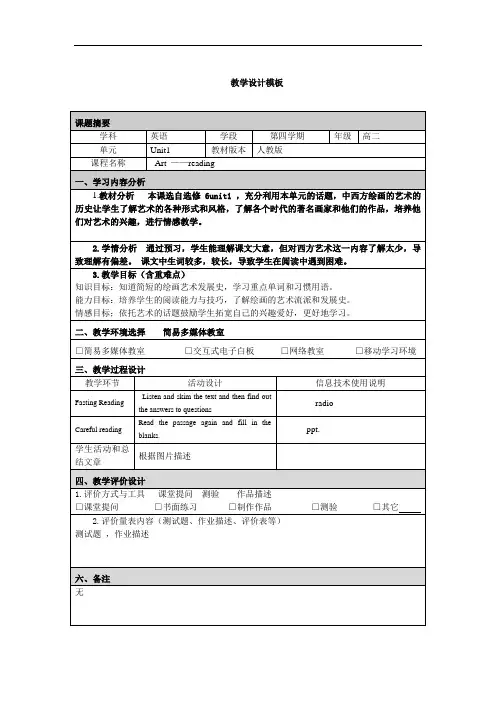
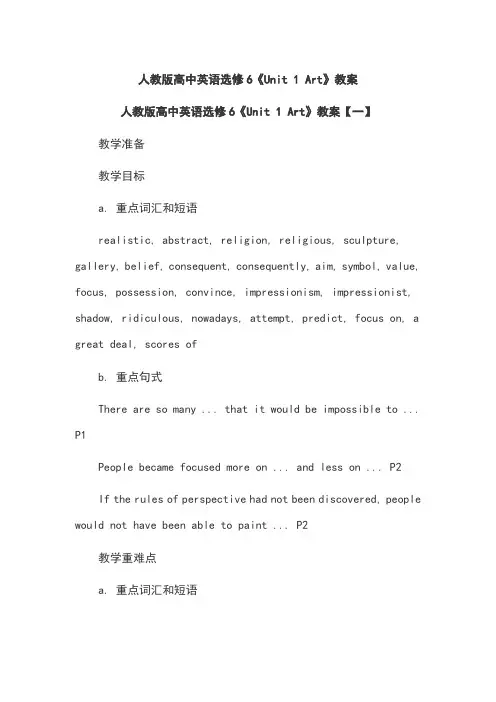
人教版高中英语选修6《Unit 1 Art》教案人教版高中英语选修6《Unit 1 Art》教案【一】教学准备教学目标a. 重点词汇和短语realistic, abstract, religion, religious, sculpture, gallery, belief, consequent, consequently, aim, symbol, value, focus, possession, convince, impressionism, impressionist, shadow, ridiculous, nowadays, attempt, predict, focus on, a great deal, scores ofb. 重点句式There are so many ... that it would be impossible to ... P1People became focused more on ... and less on ... P2If the rules of perspective had not been discovered, people would not have been able to paint ... P2教学重难点a. 重点词汇和短语realistic, abstract, religion, religious, sculpture, gallery, belief, consequent, consequently, aim, symbol, value, focus, possession, convince, impressionism, impressionist, shadow, ridiculous, nowadays, attempt, predict, focus on, a great deal, scores ofb. 重点句式There are so many ... that it would be impossible to ... P1People became focused more on ... and less on ... P2If the rules of perspective had not been discovered, people would not have been able to paint ... P2教学过程Teaching procedures:【写一写】(Some pictures are given to the students to learn some about western paintings)写出所有相应关于作品的英语名称______________________________________________________________________________________________________________________ _______________________【想一想】Which style of paintings do you prefer, western or Chinese? Why?___________________________________________________________ __________________【skimming】Skim the text and complete the main idea of it.The text mainly tells us _____ of the major movements in ________ art over the centuries.绘制时间轴课文P3---exercise 1【判一判】1. Western art has changed very little over the last seventeen centuries.2. Painters in the Middle Ages did not use perspective.3. Impressionists painted landscapes.4. You cannot recognize any object in abstract modern art.5. In the Renaissance most artists painted indoors.6. Abstract art is still art style today.【选一选】Choose the best answer.1. According to the text, art is least influenced by________.A. social changesB. the way of lifeC. the development of agricultureD. beliefs of a people2. When did painters mainly focus more on people and less on religion?A. From 5th to 15th century AD.B. From 15th to 16th century.C. From late 19th to early 20th century.D. From 20th century to today.3. Who were the first to paint outdoors?A. Painters in the Middle Ages.B. Painters in the Renaissance.C. The Impressionists.D. Contemporary painters.【巩固训练】讲练通---P2 retelling课后习题【Homework】课时跟踪训练人教版高中英语选修6《Unit 1 Art》教案【二】教学准备教学目标1. 知识与技能目标(1)通过阅读有关曼哈顿著名的艺术博物馆加深对博物馆的了解和认识。
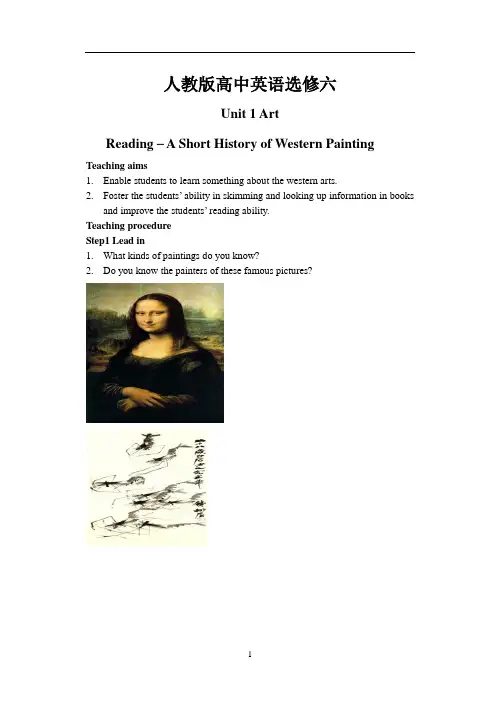
人教版高中英语选修六Unit 1 ArtReading – A Short History of Western PaintingTeaching aims1.Enable students to learn something about the western arts.2.Foster the students’ ability in skimming and looking up information in booksand improve the students’ reading ability.Teaching procedureStep1 Lead in1.What kinds of paintings do you know?2.Do you know the painters of these famous pictures?Step2 Fast reading1. In what order is the passage organized?2. How many western styles are mentioned in the passage and what are they? Step3 Careful readingPara.1:1. What is art influenced?2. Did western art change a lot?The Middle Ages1.What is the aim of painters during the Middle Ages?2. What were the artists not interested in and what were they interested in ? The Renaissance1.In the Renaissance, what did people focus on?2. How did Masaccio paint his paintings?3. What kind of paints were developed at this time?Impressionism1.What happened to Europe in the late 19th century?2. What did the impressionists want to show?3. Why did the impressionists have to paint quickly?4. Why did many people become very angry about the paintings?Modern Art1.What is impressionist paintings accepted as?2.What would have happened if there had been no impressionists?3.What were the qualities of modern art?Step4 Post-reading: True/false questionsStep 5 Writing你的朋友小明最近在学习西方绘画历史方面遇到了难题。
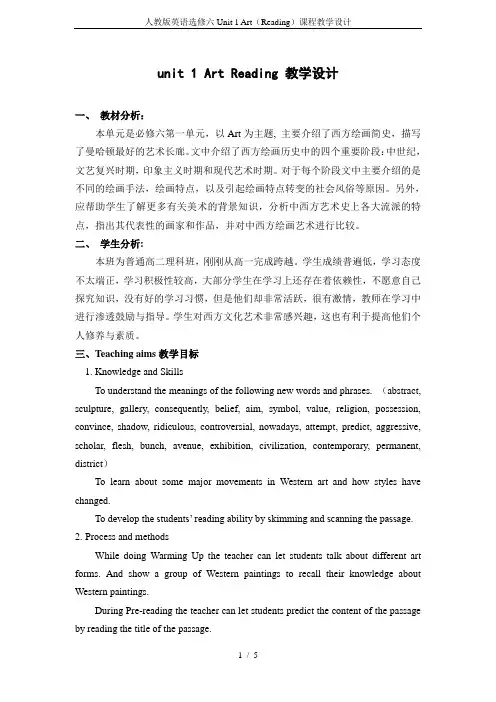
unit 1 Art Reading 教学设计一、教材分析:本单元是必修六第一单元,以Art为主题, 主要介绍了西方绘画简史,描写了曼哈顿最好的艺术长廊。
文中介绍了西方绘画历史中的四个重要阶段:中世纪,文艺复兴时期,印象主义时期和现代艺术时期。
对于每个阶段文中主要介绍的是不同的绘画手法,绘画特点,以及引起绘画特点转变的社会风俗等原因。
另外,应帮助学生了解更多有关美术的背景知识,分析中西方艺术史上各大流派的特点,指出其代表性的画家和作品,并对中西方绘画艺术进行比较。
二、学生分析:本班为普通高二理科班,刚刚从高一完成跨越。
学生成绩普遍低,学习态度不太端正,学习积极性较高,大部分学生在学习上还存在着依赖性,不愿意自己探究知识,没有好的学习习惯,但是他们却非常活跃,很有激情,教师在学习中进行渗透鼓励与指导。
学生对西方文化艺术非常感兴趣,这也有利于提高他们个人修养与素质。
三、Teaching aims教学目标1. Knowledge and SkillsTo understand the meanings of the following new words and phrases. (abstract, sculpture, gallery, consequently, belief, aim, symbol, value, religion, possession, convince, shadow, ridiculous, controversial, nowadays, attempt, predict, aggressive, scholar, flesh, bunch, avenue, exhibition, civilization, contemporary, permanent, district)To learn about some major movements in Western art and how styles have changed.To develop the students’ reading ability by skimming and scanning the passage. 2.Process and methodsWhile doing Warming Up the teacher can let students talk about different art forms. And show a group of Western paintings to recall their knowledge about Western paintings.During Pre-reading the teacher can let students predict the content of the passage by reading the title of the passage.Reading and comprehending: the teacher asks students to read the passage quickly to get its structure. After that, the teacher lets students read carefully to get more detailed information.Post-reading: let student retell the passage in their own words at the end of the class.3.Emotion, attitude and valueTo stimulate students’ sense of beauty and the ability of understanding, enjoying and creating beauty.To develop students’ sense cooperation learning.四、Teaching important points教学重点1. Enable the students to grasp the new words and impressions.2. Try to get the main idea of the text and improve the students’ reading abilities.五、Teaching difficult points教学难点1. Help the students learn how to talk about the short history of Western painting.2. Enable the students to talk about their opinions about different styles of Western art.六、Teaching aids 教具The multimedia , blackboard七、Teaching method教学方法Task-Based Language Teaching, Skimming and scanning, Discussion八、Teaching procedures教学过程Step 1. GreetingsGood morning, everyone! So happy to see you here.Step 2. RevisionLast class, we have learned the new words, now let us have a short review. Please open your book and turn to page 89, and read follow me.设计意图:本班学生基础较差,基础的单词必须每节课都巩固,上课读一遍,加强记忆,有助于更好理解课文,并且为以后学习打好基础。
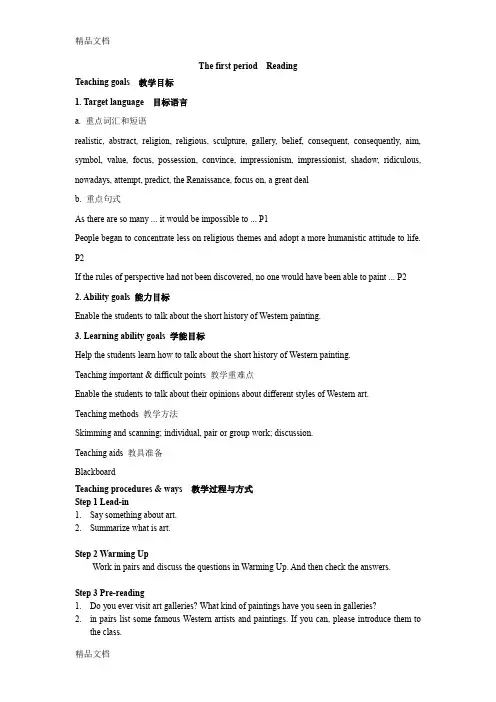
The first period ReadingTeaching goals 教学目标1. Target language 目标语言a. 重点词汇和短语realistic, abstract, religion, religious, sculpture, gallery, belief, consequent, consequently, aim, symbol, value, focus, possession, convince, impressionism, impressionist, shadow, ridiculous, nowadays, attempt, predict, the Renaissance, focus on, a great dealb. 重点句式As there are so many ... it would be impossible to ... P1People began to concentrate less on religious themes and adopt a more humanistic attitude to life. P2If the rules of perspective had not been discovered, no one would have been able to paint ... P2 2. Ability goals 能力目标Enable the students to talk about the short history of Western painting.3. Learning ability goals 学能目标Help the students learn how to talk about the short history of Western painting.Teaching important & difficult points 教学重难点Enable the students to talk about their opinions about different styles of Western art.Teaching methods 教学方法Skimming and scanning; individual, pair or group work; discussion.Teaching aids 教具准备BlackboardTeaching procedures & ways 教学过程与方式Step 1 Lead-in1.Say something about art.2.Summarize what is art.Step 2 Warming UpWork in pairs and discuss the questions in Warming Up. And then check the answers.Step 3 Pre-reading1.Do you ever visit art galleries? What kind of paintings have you seen in galleries?2.in pairs list some famous Western artists and paintings. If you can, please introduce them tothe class.Step 4 Reading2.Read the text carefully again and answer the questions.(1) What were the artists interested in from 5th to 15th century AD?(2) How did Masaccio paint his paintings?(3) Why did the impressionists have to paint quickly?3. According to the text, finish exercise 3 on page 3 by yourselves. Then check the answers.4. What is the writing style of the passage?------The passage is a historical narrative article. It briefly introduces the main features of different Western painting styles during the main periods of times. It also analyzes why and how the styles changed. The short history of Western painting styles is described clearly and vividly, which gives the readers deep impression.5. How about its writing characteristic?------The writing characteristic of it is: Arranged well in the order of time; Catch the features of people and things and use adjectives very exactly; Lay the stress on the main subjects and purpose, writing details and briefs properly; Insert the typical paintings to make the passage more vivid and lively.Step 5 Homework1. Underline the time expressions in the reading passage.2. Retell the passage with the help of the chart about the text.3. Memorize the new words and expressions.。
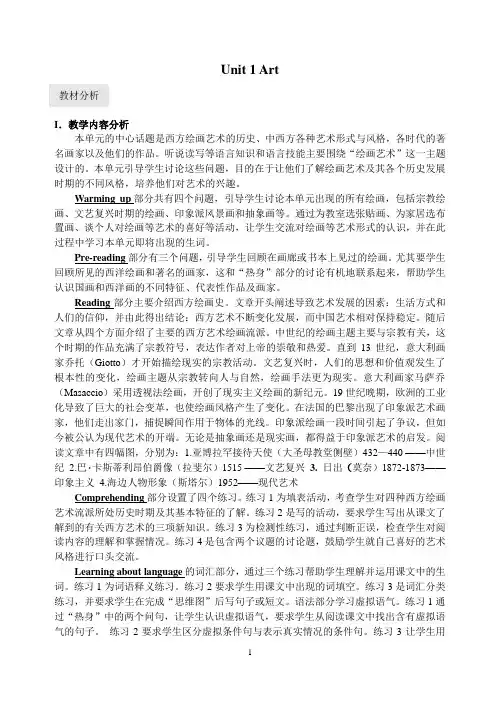
Unit 1 Art教材分析I.教学内容分析本单元的中心话题是西方绘画艺术的历史、中西方各种艺术形式与风格,各时代的著名画家以及他们的作品。
听说读写等语言知识和语言技能主要围绕“绘画艺术”这一主题设计的。
本单元引导学生讨论这些问题,目的在于让他们了解绘画艺术及其各个历史发展时期的不同风格,培养他们对艺术的兴趣。
Warming up部分共有四个问题,引导学生讨论本单元出现的所有绘画,包括宗教绘画、文艺复兴时期的绘画、印象派风景画和抽象画等。
通过为教室选张贴画、为家居选布置画、谈个人对绘画等艺术的喜好等活动,让学生交流对绘画等艺术形式的认识,并在此过程中学习本单元即将出现的生词。
Pre-reading部分有三个问题,引导学生回顾在画廊或书本上见过的绘画。
尤其要学生回顾所见的西洋绘画和著名的画家,这和“热身”部分的讨论有机地联系起来,帮助学生认识国画和西洋画的不同特征、代表性作品及画家。
Reading部分主要介绍西方绘画史。
文章开头阐述导致艺术发展的因素:生活方式和人们的信仰,并由此得出结论:西方艺术不断变化发展,而中国艺术相对保持稳定。
随后文章从四个方面介绍了主要的西方艺术绘画流派。
中世纪的绘画主题主要与宗教有关,这个时期的作品充满了宗教符号,表达作者对上帝的崇敬和热爱。
直到13世纪,意大利画家乔托(Giotto)才开始描绘现实的宗教活动。
文艺复兴时,人们的思想和价值观发生了根本性的变化,绘画主题从宗教转向人与自然,绘画手法更为现实。
意大利画家马萨乔(Masaccio)采用透视法绘画,开创了现实主义绘画的新纪元。
19世纪晚期,欧洲的工业化导致了巨大的社会变革,也使绘画风格产生了变化。
在法国的巴黎出现了印象派艺术画家,他们走出家门,捕捉瞬间作用于物体的光线。
印象派绘画一段时间引起了争议,但如今被公认为现代艺术的开端。
无论是抽象画还是现实画,都得益于印象派艺术的启发。
阅读文章中有四幅图,分别为:1.亚博拉罕接待天使(大圣母教堂侧壁)432—440 ——中世纪 2.巴۰卡斯蒂利昂伯爵像(拉斐尔)1515 ——文艺复兴3. 日出(莫奈)1872-1873——印象主义4.海边人物形象(斯塔尔)1952——现代艺术Comprehending部分设置了四个练习。
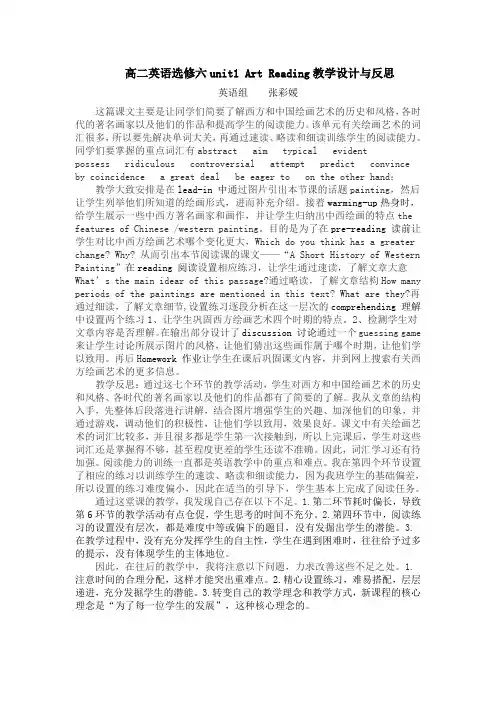
高二英语选修六unit1 Art Reading教学设计与反思英语组张彩媛这篇课文主要是让同学们简要了解西方和中国绘画艺术的历史和风格,各时代的著名画家以及他们的作品和提高学生的阅读能力。
该单元有关绘画艺术的词汇很多,所以要先解决单词大关,再通过速读、略读和细读训练学生的阅读能力。
同学们要掌握的重点词汇有abstract aim typical evidentpossess ridiculous controversial attempt predict convince by coincidence a great deal be eager to on the other hand;教学大致安排是在lead-in 中通过图片引出本节课的话题painting,然后让学生列举他们所知道的绘画形式,进而补充介绍。
接着warming-up热身时,给学生展示一些中西方著名画家和画作,并让学生归纳出中西绘画的特点the features of Chinese /western painting。
目的是为了在pre-reading 读前让学生对比中西方绘画艺术哪个变化更大,Which do you think has a greater change? Why? 从而引出本节阅读课的课文——“A Short History of Western P ainting”在reading 阅读设置相应练习,让学生通过速读,了解文章大意W hat’s the main idear of this passage?通过略读,了解文章结构How many periods of the paintings are mentioned in this text? What are they?再通过细读,了解文章细节,设置练习逐段分析在这一层次的comprehending 理解中设置两个练习1、让学生巩固西方绘画艺术四个时期的特点。
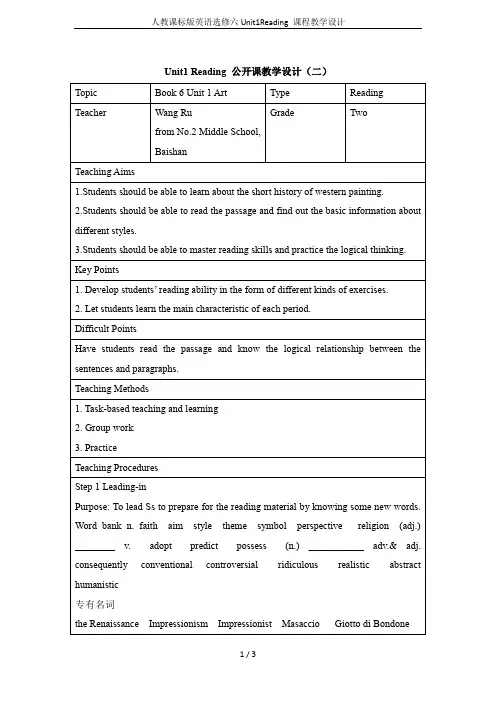
Unit 1 Art READINGTeaching aims1) Enable students to learn something about the Western arts and learn how to describe a painting.2) Enable the students to learn the different styles of the Western arts.3) Target languageTeaching important pointsHow to make students tell the characteristics and styles of the Western arts.Teaching difficult pointsHow to develop students’ reading abilityTeaching aidsA multimedia and a blackboardTeaching proceduresStep1 Lead-inShow some pictures painted by studentsStep2 Pre-readingAsk the students some questions:1. Can you name some famous Western or Chinese paintings and painters? Who are your favorite painters, from China and from other countries?2. The following paintings are all very famous. Can you guess their names and their painters?3.Match the words with thecorrect meanings:[A] [B]a. realistic 1. accurate, minuteb. abstract 2. state or fact of existingc. existence 3. being in thought but having a physical or practical existenced. detailed 4. lifelike, true to lifee. religious 5. classical, of old beliefsf. traditional 6. sincere to believe in a god or godsStep3 ReadingTask 1 Fast-readingRead the text quickly and answer the following questions.1.What’s the main idea of the text?2. How many styles are mentioned in the passage and what are they?3. How is the passage organized?Task 2 Careful-reading1.Read the text again and fill in the blanks..1). This text will describe only the most important ones, starting from _____.2). During the Middle Ages, the main aim of painters was to_________.3). During the Renaissance,_______gradually replaced those held in the Middle Ages.4)One of the most important discoveries _____________was how to draw things in perspective.5).________________, oil paints were also developed at this time.6). ________. they were convinced they were looking through a hole in a wall at a real scene.7). ___________________, the impressionists’ paintings were controversial.8). Who can predict what painting styles there will be_____the table3. True or False.1). Western art has changed very little over the last 17 centuries.2). Paintings in the Middle Ages did not use perspective.3). Impressionists painted landscapes.4). You cannot recognize any object in abstract modern art.5). In the Renaissance most artists painted indoors.6). Abstract art is still an art style today. 4.Comprehending1). Which of the following statements is true?A. Paintings in Middle Ages were very realistic.B. Western art has changed a lot since the 5th century.C. Impressionist paintings were painted mainly indoors.D. Modern art began in the Renaissance.2). In the Renaissance, painters___.A.painted religious scenes in a more realistic style.B. focused more on religion than on humans.C. began to paint outdoors.D. returned to classical Roman and Greek ideas about art.3). At first most people hated the impressionists’ style of painting, because _____.A.their paintings were very abstract.B.heir paintings were very realistic.C.They broke away from the traditional style of painting.D. their paintings were very ridiculous.4). ____discovered how to make paintings look more real by using perspective.A. Giotto di Bondone.B. Masaccio.C. Claude Monet.D. Pablo Picasso5). When did people focus more on people and less on religion?A. From 5th to 15th century AD.B. From 15th to 16th century.C. From late 19th to early 20th century.D. From 20th century to today.Step 4 Post-readingThe style of Western art has changed many times, while Chinese art has changed less often. Art is _influenced by the way of life and beliefs .During the Middle Ages, the main aim of painters was to represent _religious__ themes. Artists were interested in creating _love and _respect__for God.In the Renaissance, people focusd more on _humans__and less on _religion___. Artists tried to paint people and nature as they really were. Masaccio used _perspective__ in his paintings which made people_convinced__ they were looking through a hole in the wall at a real scene.In the late 19th century, Europe changed _a great deal __ , from a mostly agricultural society to a mostly industrial one. The _impressionists_ were the first to paint outdoors. They had to paint _quickly__ and their paintings were not detailed as those of earlier painters.Today people accept impressionists’ paintings as the beginning ofmodern art. Some modern art is_abstract__while some is _realistic__.Step 5 DiscussionCan you tell which period the following pictures belong to? Can you describe them?Step 6 ConsolidationUseful sentences1.People began to concertrate less on religious themes and adopt a more humanistic attitude to life.2.By coincidence, oil paints were also developed at this time, which made the colours used in paintings look richer and deeper.3.They paid famous artists to paint pictures of themselves, their houses and possessions, as well as their activities and achievements.4.Without the new paints and the new technique, we would not be able to see the many great masterpieces for which this period is famous.5.On the one hand, some modern art is abstract; that is, the painter does not attempt to paint objects as we see them with our eye.Step 9 Homework1. Review and retell the text, pay attention to some key words, useful expressions and difficult sentences.2. Recite the useful sentences3. Choose one of the above paintings and write a shortdescription of it, including its style, its painter and your understanding.精美句子1、善思则能“从无字句处读书”。
A Teaching Plan
Teacher: Xiao Ziquan
Class:Class1, Senior 2
Teaching time:Nov.14, 2018
Teaching content: Reading
Teacher: Module 6 Unit 1 Art Reading
Teaching goals:
1.To enable the students to have a knowledge of the short history of Western
painting.
2.To improve the students’ reading ability.
Teaching important & difficult points
Enable the Ss to talk about the short history of Western painting
Teaching methods
Skimming and scanning; individual, pair or group work; discussion
Teaching aids
A computer, a tape recorder and a projector.
Teaching procedures & ways
Step I Lead-in
To lead in such a topic by mentioning the sculptures or paintings around the students, for example, sculptures on the campus, famous paintings hanging on the walls of the corridor of the school building, etc. Ask Ss to figure out their functions and the general term to call them---the works of art
Step II Warming-up
Show some famous paintings and ask : Do you know the following famous paintings and painters?
Mona Lisa Smile → Leonardo Da Vinci (Italian, 1452-1519)
Sunflowers & starry night → Vincent van Gogh (Dutch, 1853-1890)
Water Lilies → Claude Monet (French, 1840-1926)
Dream & Seated woman → Pablo Picasso (Spanish, 1881-1973)
Ask: Can you tell the ages of the paintings?
Say : Today we’ll learn about the short history of western painting.
Step III Reading
1. Comparison: Make a comparison of Western and Chinese painting and ask: Which do you think has a greater change? Why?
2. Scanning
Read Para. 1, and answer the question.
Scan Para2-5, and find the representative artists and the features of their paintings. Names of Ages Time Artist Feature
The Middle Ages 5th to 15th
century
Giotto Di
Bondone
religious,
realistic
The Renaissance 15th to 16th
century Massaccio perspective,
realistic
Impressionism Late 19th to early
20th century /detailed,
ridiculous
Modern art 20th century to /Controversial,
today abstract, realistic
3. Careful reading
Read the text carefully and find some detailed information.
The Middle Ages Features:
1.theme: religion
2.Artists were not interested in showing nature and people as…but interested in creating respect and love for God.
The Renaissance
Masaccio:the first person to use perspective in painting
1.Focused more on humans and less on religion.
2.Two developments: a. Drawing things in perspectives
b. Oil painting.
Impressionism
1.What changes led to the change in painting styles?
2.Look at these paintings, what did they paint?
3.Why did the impressionist have to paint quickly?
Modern art
Two extremes
Step IV Comprehending
Ask the students to read the passage again and deal with Exercises.
Step V Homework
1.Underline the useful expressions and the time expressions in the reading passage.
2.Retell the passage with the help of the chart about the text.
Blackboard Design:
Unit1 Art
Reading
↓
↓
↓
Teaching reflection:。